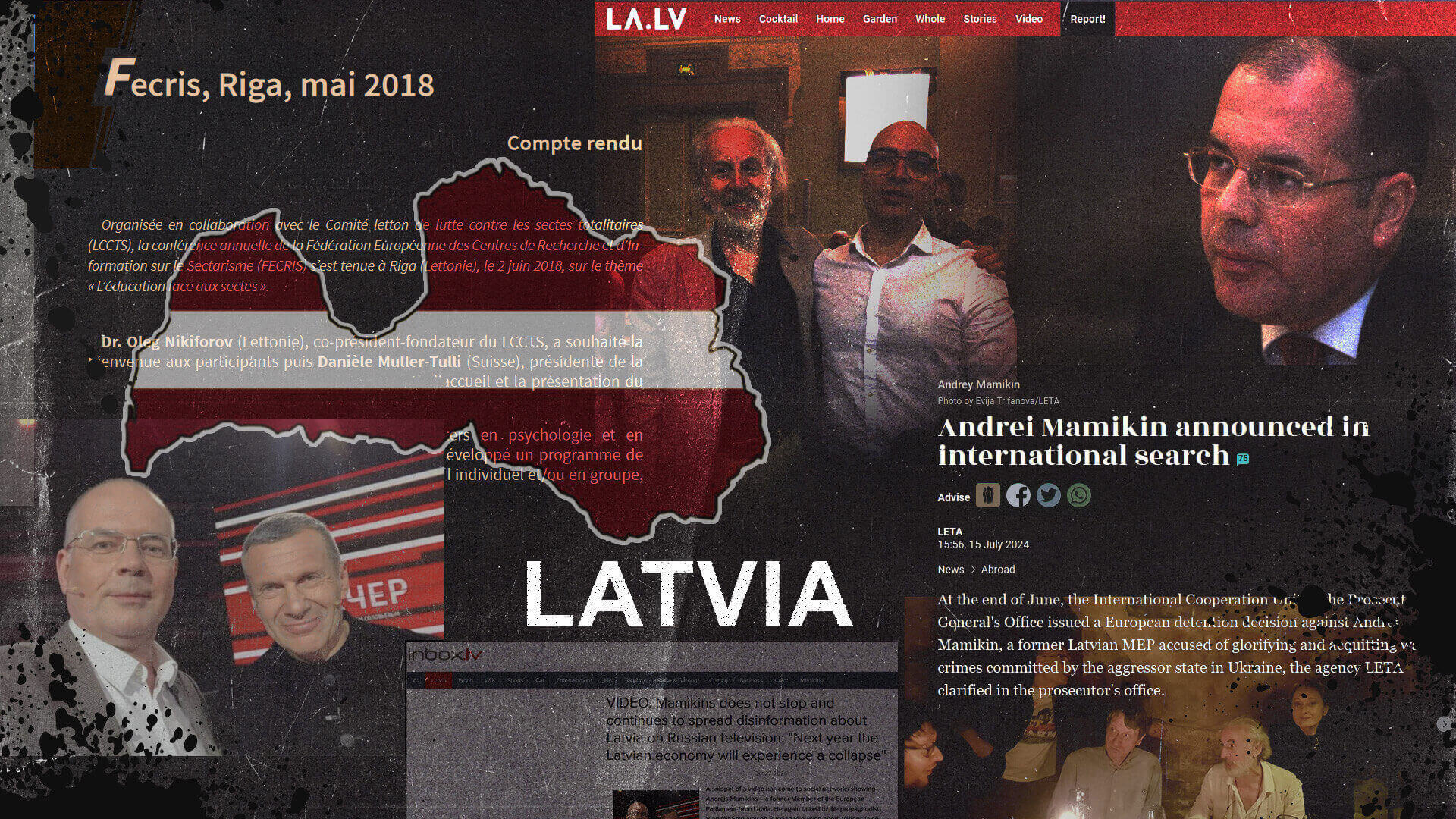Beware! Cult! What do you feel when you hear this? You feel threatened, afraid, and you want to back away, don’t you? And you certainly don’t want to communicate with those who have been “brainwashed”.
Stigmatization means attaching negative labels to an individual, a group of people or an idea to form negative attitudes towards them. It is firmly embedded in our lives. It is common for us to say: “he is stupid,” “she is deranged,” or “they are sectarians.” A “cultist” or a “sectarian” is a mark of shame in our society. But do you really know the truth behind these labels? Who is pushing us to label each other this way, and for what purpose?
Stigmatization, or labeling, is one of the most effective methods to manipulate public opinion by creating negative images in people’s minds. Few people realize how dangerous it is. In present-day society, it’s a method to dehumanize individuals or groups of people in the eyes of community. This method divides people, fostering hatred towards relatives, friends, acquaintances, and even strangers. More alarmingly, this is a method of turning people into potential killers.
A label pinned on someone is perceived by people’s consciousness as a conclusion, a kind of established opinion about an individual or an organization, which does not require facts or evidence. In other words, it is accepted without thinking, analyzing or understanding. At the same time, a label completely abrogates any positive qualities of the discredited personality, group or organization in the eyes of other people. Stigmatized individuals become targets; they are hated, despised and shunned. They are treated with anger and disgust. They are subconsciously treated with a whole range of negative reactions: from dismissive avoidance to violence, including murder.
Suffice it to recall the terrible example of stigmatization in Nazi Germany — the yellow star badges that Jewish people were forced to wear under the Nazi regime in Germany and in the occupied countries during World War II. These badges, typically shaped as the Star of David and containing an inscription “Jude” (the German word for “Jew”), were used to identify, humiliate and isolate the Jewish population. “You’re a Jew; you are the reason for the misfortune of the German people.” And then, the terrible genocide followed.

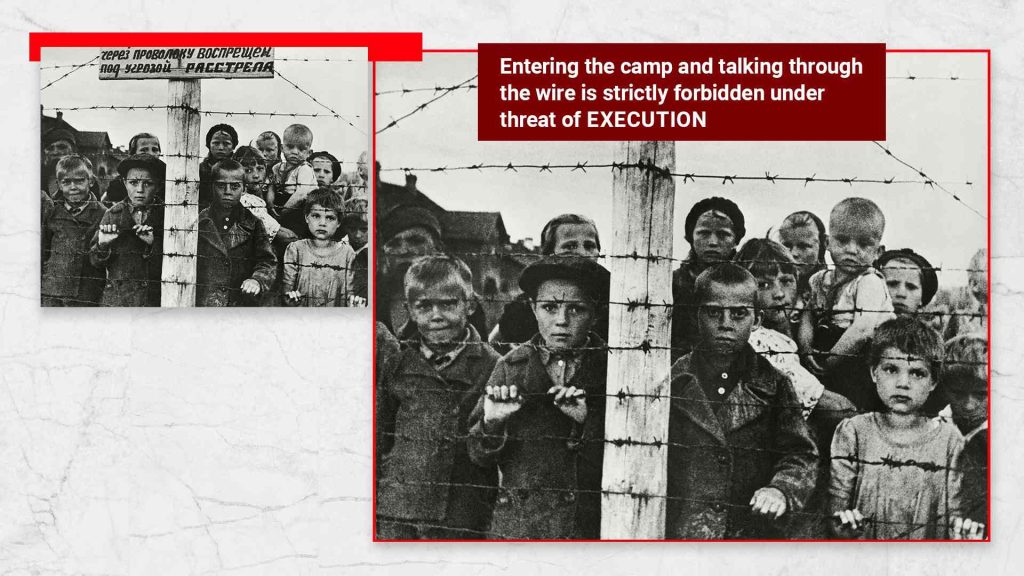
Stigmatization is dangerous because at any moment anyone can become an outcast in society. Absolutely anything can be made a reason for stigmatization: your nationality, opinions, beliefs, or affiliation with any community. It is often stigmatization that underlies discrimination — the infringement of people’s rights based on certain characteristics.
In ancient Greece, a stigma was a brand mark burned on the bodies of criminals, traitors and slaves. Now, let’s examine who allows themselves to stigmatize others in the present-day democratic society, and what for. Let’s revisit the terrible labels: “cult”, “sect”, “cultist”, and “sectarian”. Interestingly, the word “sect” originally referred to a group of people who had separated themselves from a larger community. From a historical point of view, most religions and religious communities began as sects.
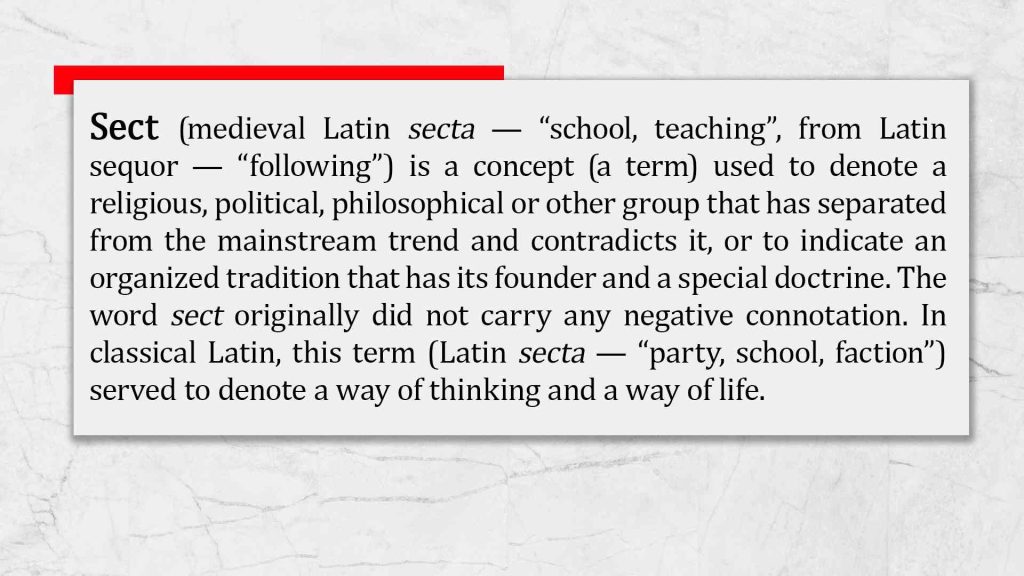
Sect (medieval Latin secta — “school of thought, teaching”, from Latin sequor, meaning “to follow”) is a concept (term) used to denote a religious, political, philosophical or other group that had separated from the mainstream trend and held opposing views. It could also refer to an organized tradition with a distinct founder and special doctrine. The word sect originally did not carry any negative connotation. In classical Latin, this term (secta — “party, school, faction”) simply referred to a way of thinking and a way of life.
“In the 11-17th centuries, the word ‘sect’ was used as a synonym for a literary, philosophical, political or religious school of thought or society. Any philosophical circle, religious community, literary salon, order (in the meaning of both a philanthropic society and a subdivision of the Catholic Church, for example), and even any political party could be called a ‘sect’.”
Bertil Persson
“The history of using the method of stigmatization by means of labels and shameful brands is closely intertwined with the activities of anti-cult organizations and totalitarian regimes throughout the history of mankind. Anti-cult organizations have always been fervent fighters against cults and sects, and it was exactly them who initially caused neutral words to acquire an extremely negative connotation. Nowadays, their leaders claim to be experts in identifying which religious or non-religious organizations are “totalitarian sects” or “destructive cults.” Adding the adjectives “totalitarian” or “destructive” to the words “sect” and “cult” has given these labels a sinister meaning, reinforcing the perceived “danger” of the communities on which the labels are pinned. Please note that non-religious organizations are also being stigmatized. If you think that anti-cult entities only fight against “dissent” within specific religious trends, you are mistaken. They monitor each of us and target everyone who dares to have their own opinion, who thinks and acts differently from what has been prescribed. Prescribed by whom? This is the question we are going to answer. ”2
Where does anti-cultism actually originate from?
To understand this, let’s look at the history of early Christianity, or more precisely, specifically the persecution of the first Christians.
Many diverse religious schools that emerged in the first centuries after Christ’s advent, nearly becoming the dominant form of Christianity, were collectively known as Gnosticism. The term gnostic comes from the Greek word gnosis, meaning “knowledge”. A Gnostic is someone who has acquired special knowledge and lives according to it. In this respect, the term gnosis does not carry any negative connotation.
The term gnostic acquired a negative meaning when the early church fathers applied it to some groups of believers who were widely known at that time and broke away from the church’s teaching. Up to the 2nd century AD, there were numerous Christian groups in the Mediterranean region, falling under the name Gnostics: Simonians, Nicolaitans, Ophites, Naassenes, Sethians, Perates, Basilidians, Carpocratians, Valentinians, Marcosians. Those were whom the early church fathers called heretics, declaring Gnostic writings to be heresy. In modern terms, they labeled them as “sects”.
Heresy (from the Greek αἵρεσις, meaning “choice, trend, school, teaching, sect”) refers to a conscious deviation from a religious teaching considered correct by someone. Such a deviating trend offers a different approach to religious teaching. Thus, representatives of two different branches of a religious teaching can mutually accuse each other of heresy.
Saint Irenaeus of Lyon was the first to use the term heresy in a negative sense, referring to the heresy of Simon the Samaritan (Acts 8:9-24).
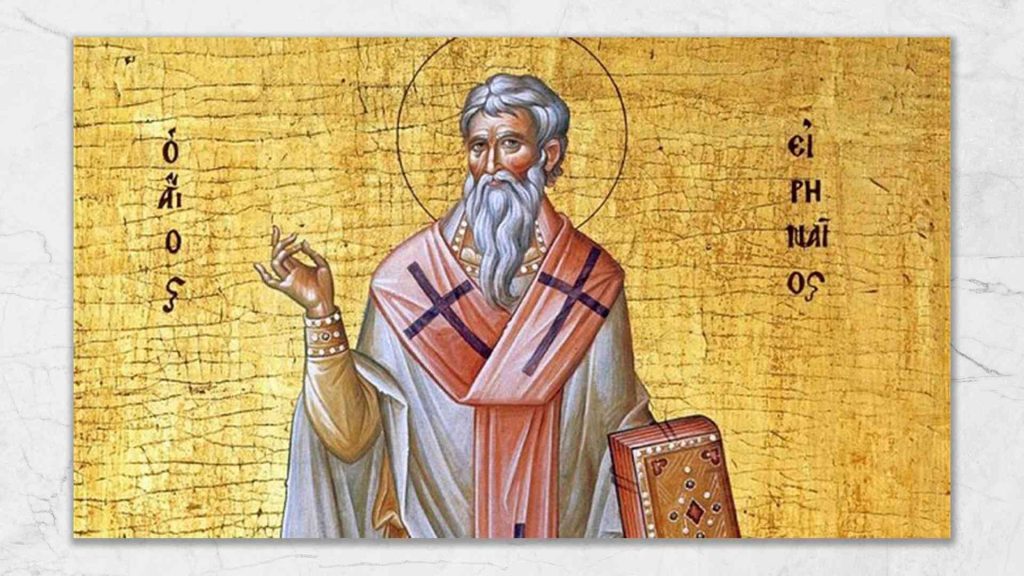
St. Irenaeus reported that Simon’s followers spread throughout Alexandria, Asia Minor and Rome, so “whole crowds of Gnostics appeared like mushrooms after rain.” (Against Heresies, I, 29,1) It is interesting that when forming the negative image of Jews, Nazis compared them to poisonous mushrooms. A coincidence? Unlikely.
Among all the varieties of Gnostics mentioned above, the Valentinians are the most famous. As St. Irenaeus said, they acted inside the church and were like a “wild beast rising to leap.” This church father fought against them even more straightforwardly. Let’s recall how the first Christians were generally fought against. Christians were put to death, thrown to wild animals in circuses, turned into live torches to illuminate night festivities, tortured or buried alive. Meanwhile, masses of people who witnessed those atrocities were in immense fear of becoming one of them — one of those who dared to think or believe in a different way. Those were the terrible consequences of the method of stigmatization, branding or labeling — the method that has acquired an incredible scale nowadays.
In the first centuries AD, Christians were accused of all probable and improbable crimes that could only be imagined: they allegedly violated state laws, were destroying the state itself and the family institution, committed debauchery, infanticide, blasphemy, and whatnot. They were accused of professing a faith other than the state religion. St. Irenaeus said that people “not strong-minded and gullible, especially women” were susceptible to heresies (various sectarian teachings). Irenaeus himself was often a witness to subsequent repentance of the “seduced”. A familiar story? Isn’t this the image of a sectarian or a cultist formed in the minds of people by modern anti-cult organizations?
“Writings of St. Justin Martyr and other Christian writers of the 2nd century adjoining him, by the nature of their works, represent the apologetic activity of the ancient church, an activity turned outwards and directed against external enemies. In his work, the later fathers and teachers of the church sought for testimonies of truth; in modern times, Roman Catholic and Protestant theologians have appealed to his authority to settle disputes about professing faith and to clarify matters concerning the canon of sacred books, the history of rites and dogmas of the church.”1
“Historians emphasize the fact that it was the church’s anti-Semitism that determined the distinctive character of the German national movements, that is, Nazism itself. Thus, the radical vector against Jews and dissenters was set long before the Gestapo emergence. It is interesting that in 1933, immediately after its establishment, the Gestapo started adopting practices and exchanging documents specifically with the anti-cult Apologetic Center. Protestant pastors with radical views constantly urged the Gestapo to tighten measures against Jews and dissenters.”
When you compare all these facts, it becomes obvious: it’s not a coincidence that the Center for Religious Studies (CRS) created in 1993 by A. Dvorkin (one of the leaders of the modern anti-cult movement which, in essence, is a new Nazism) was named after Irenaeus of Lyon. This center was established with the support of the Russian Orthodox Church, and in its model, it’s a carbon copy of the Nazi Apologetic Center that collaborated with the Gestapo.
What was so dangerous about the teaching professed by the Gnostics?
“Gnosticism is not only the doctrine of faith in the existence of God, but also the path by which direct knowledge (“gnosis”) of God, or a believer’s personal communion with him, is attained. Followers of Gnosticism placed personal spiritual knowledge (gnosis) above orthodox teachings, traditions, and the authority of conventional religious institutions.” In plain words, they believed that one doesn’t need intermediaries such as the church fathers for communion with God and spiritual salvation. Isn’t this what Jesus was talking about?
“But you, do not be called ‘Rabbi’; for One is your Teacher, the Christ, and you are all brethren. Do not call anyone on earth your father; for One is your Father, He who is in heaven. And do not be called teachers; for One is your Teacher, the Christ.” 3 Matthew 23:8-10
Let’s compare Jesus’ words with the concept of “Church Fathers”
Church Fathers (Greek Ἐκκκλησιαστικοί Πατέρες; in Orthodoxy, Holy Fathers): an honorary title used since the end of the 4th century in reference to a group of prominent church ministers and writers of the past, whose authority had special weight in shaping the dogma, hierarchical organization and worship of the church, as well as in compiling the canon — the list of the Holy Books of the Bible (separating the divinely inspired books from the apocrypha).
Title (from Latin titulus, meaning “inscription”; “honorary status”) is an honorary rank (e.g., count, duke) which is hereditary or granted for lifetime to individuals (usually nobles) to emphasize their special privileged position.
A logical question arises: which ones were the true followers of Christ’s teaching? And who were those who brutally slaughtered them? Is it permissible in general to accuse, persecute and exterminate people because they believe in something in a certain way?
The next striking period of anti-cult organizations’ activity is the time of Inquisition in the Middle Ages
Here’s what Bertil Persson, Swedish professor of comparative religion, PhD in theology, wrote about it in his book The Fight Against Sects4:
“In 364, the Roman Empire was divided into the Western Roman Empire and the Eastern Roman Empire, each with its own emperor. In 1054, there was a schism between the Western Roman Church and the Eastern Christian (Orthodox) Church. Hierarchs of the Western Roman Church labeled communities of the Christ Movement in the Eastern Church as sects. In 1184, for the first time, special ‘faith-guarding’ police officers were appointed to implement decisions of the Councils. To eradicate heretics once and for all, in Rome, in 1215, the Fourth Lateran Council established the Inquisition, a special institution tasked with public condemnation of heretics, protection of the church, and collection of information about heresies and sects. In 1224, Frederick II (Emperor of the Holy Roman Empire, 1212-1250) approved a law requiring heretics to be burned at the stake. In 1231, Pope Gregory IX (1227-1241) established a special Inquisition court.”
It turns out that the Christian Orthodox Church was originally a sect, and the followers of Christ’s teaching were sectarians. Hierarchs of the Western Roman Church were ardent fighters against sects and cults, that is, anti-cultists, who established the Inquisition and were engaged in persecution of “sectarians” and “cultists” by committing the cruelest massacres against them.
“The rampant crackdown reached its peak after 1484, when Innocent VIII (the Pope from 1484 to 1492) appointed Germans Heinrich Kramer (1430-1505) and Jacob Sprenger (1436-1495), monks of the Dominican Order, to be “police guardians of the faith” with a special task of preparing a handbook for eradicating witches and heretics as adherents of sects and cults were often called back in that time. The treatise Malleus Maleficarum (“Hammer of Witches”) was completed in 1486. It was most widely used in the Germanic lands, especially Austria and Bavaria.”
Hence, the medieval “holy” Inquisition5 was the prototype of anti-cult organizations. The word inquisition still evokes horror since it implies cruel torture, brutal humiliation of people, and burning them alive at the stake. A bloody terror that lasted almost three centuries.
Monks were the police — “guardians of the Christian faith”, the faith built on the commandments of Christ! Christ said to people:
“A new commandment I give to you, that you love one another; as I have loved you, that you also love one another…”
John 13:34-35 New King James Version6
Jesus brought the teaching of Love, rooted in the freedom of choice given by God to every human being: to choose what to believe, what not to believe, to be on God’s side or not. Jesus Himself never violated these commandments, thus setting an example for his followers. Jesus spoke of the equality of people before God. Jesus taught not to judge and to be merciful:
“Therefore be merciful, just as your Father also is merciful. Judge not, and you shall not be judged. Condemn not, and you shall not be condemned. Forgive, and you will be forgiven…”
Luke 6:36-38 New King James Version7
So how, in the heart of the Christian church, could the Inquisition emerge, which brutally murdered a huge number of people just because they tried to exercise their right to be free humans and chose their own path to God?
Who could elevate themselves above God by breaking Christ’s commandments, slaughtering people and deciding who should live and who should not? Jesus warned about such people:
“This is how we know who the children of God are and who the children of the devil are: Anyone who does not do what is right is not God’s child, nor is anyone who does not love their brother and sister.”
1 John 3:10 NIV 8
So who were those executioners called the “holy inquisition”, and what did they believe in? Maniacs too believe they have the right to decide whether a person deserves to live or not, but they are recognized as dangerous to society. Just like fascism that exterminated millions of people was recognized as dangerous. Then why, to this day, haven’t anti-cultism and its followers been recognized as a dangerous threat to society and human lives?
Let’s take a look at the very roots of Nazism formation. Once again, we have to return to the church bosom and the founder of Protestantism, Martin Luther, who was “extremely intolerant of other Christian denominations and religious movements, to the point of demanding death penalty for citizens who understood the faith in Christ differently than he did.” Intolerance of any dissent and fierce anti-Semitism were characteristic features of the founder of Protestantism. The following are his direct quotes: “Therefore let everyone who can, smite, slay and stab, secretly or openly, remembering that nothing can be more poisonous, hurtful or devilish than a rebel. It is just as when one must kill a mad dog; if you do not strike him, he will strike you, and a whole land with you.”
Luther claimed that Jews were a curse on the German people and suggested that “their synagogues or schools should be burned… in honor of our Lord and Christendom.” He claimed that if he had to baptize a Jew, “he would take him to the bridge, hang a stone around his neck and push him over.” Hitler admired Luther and called him the most outstanding German genius. Many scholars view Luther as the forerunner of modern anti-Semitism and find in his attitude toward Jews the very seed of Nazi doctrine, noting that Hitler “followed Luther’s precise instructions regarding the Jews.” It was his instructions that taught National Socialists how to treat Jews and undesirable religious minorities.
However, unfortunately, that wasn’t the only source for the formation of Nazism. Throughout the history of humankind, we can observe constant presence of ideas leading to the rise of fascism, genocide, and mass terror. But all of them have a key common point: intolerance for dissent, freedom of speech and religion; and they all lead to the fight against sects and cults, i.e. to anti-cult organizations and those behind them.
Another source of ideas for National Socialism was Jörg Lanz von Liebenfels (1874-1954), aka Adolf Josef Lanz, an Austrian political and racial theorist and occultist who was a pioneer of Ariosophy. (Ariosophy is a gnostic deist religion based on anti-Semitism and racism.) He was a former monk and the founder of Ostara magazine where he published anti-Semitic and völkisch theories. He is considered to be “the man who gave Hitler his ideas.”
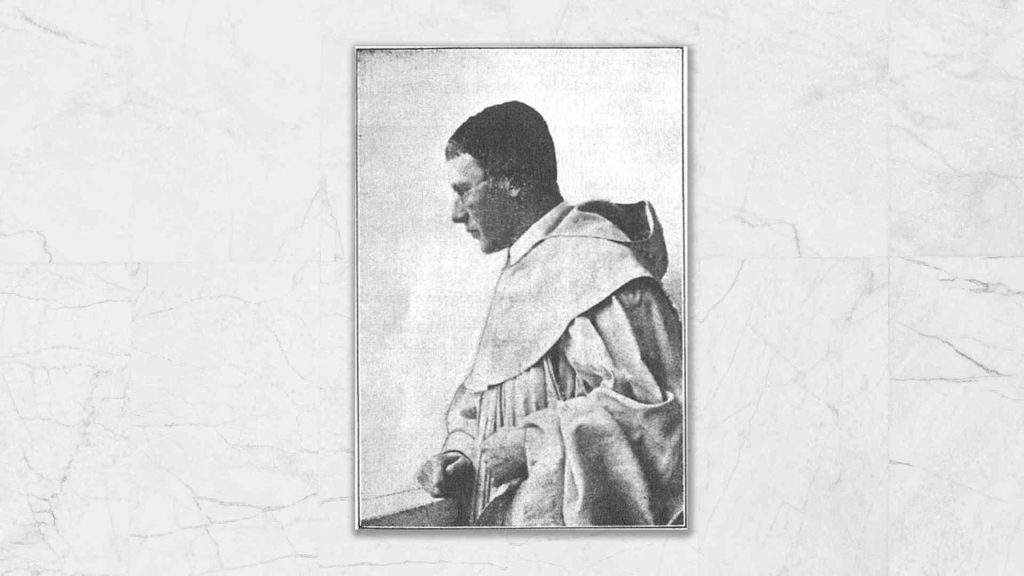
Here is what Bertil Persson writes about him: “Lanz began his career in 1893 when he became a monk of the Cistercian order in Heiligenkreuz Abbey near Vienna. In 1899, he left the monastery and married a wealthy Jewish widow. She died a few years later. In 1900, he founded the Order of the New Templars. At the same time he joined Schönerer’s movement.”

Georg Ritter von Schönerer has been called “Hitler’s spiritual father.” From 1879 and until the end of the 19th century, he was an influential leader first of the German Nationalists and then of the All-German Union. Schönerer was a radical anti-Semite and had a strong influence on the young Adolf Hitler who considered him one of his role models. Schönerer demanded the expulsion of Jews from the civil service, schools, universities, clubs, and newspapers. In 1900. The pan-Germanism movement he led demanded in the Viennese parliament that a bonus be paid for every Jew exterminated. He delivered propaganda slogans such as “A man who has matured under cool skies is obliged to exterminate parasitic races, just as one must exterminate menacing poisonous snakes and wild predatory beasts,” or other slogans like “Jew or Christian — it is all the same — there’s a pig lying within the race.”
Schönerer was a representative of the Greater Germanic Reich ideology combined with radical anti-Semitism which he consistently substantiated with “racial” motives. He adhered to a belief that Austria should be inhabited solely by German speakers. Schönerer compelled his followers to address him as Führer and greet him by shouting “Heil!”
Schönerer picked up many of his ideas from his senior German associate, Adolf Stoecker, a Protestant German theologian, politician and court chaplain.

Stoecker considered himself the “founder and father of the anti-Semitic movement.” He was “the first to make anti-Semitism the central credo of a modern political party.” Stoecker viewed Judaism as “an alien drop of blood in our national body: it’s a destructive force.” He said that fighting against Jews was a genuine racial war because “Judaism lusts for power, wants to appropriate our best property, our Christian religion, culture and our German spirit.”
Such were the teachers of Lanz von Liebenfels who, as a “religious and political expert on sects”, devoted himself to transforming these concepts and ideas into a theory that was adopted as a basis by Adolf Hitler and National Socialism.
Below are the ideas of Lanz von Liebenfels himself, a “religious and political expert on sects”:
“Lanz’s goal in the Order of the New Templars was to contrast class struggle with racial struggle and reinforce it with violence “up to a castration knife.” His ideas were designed to allow the upper class and imperialist groups to justify “any kind of exploitation.” In particular, “enslavement” of the population was to be reintroduced, and this rule was to be enforced through “castration” of those who thought otherwise. Lanz strongly condemned the Christian tradition of compassion and called for harsh actions against inferiors, including their disappearance. He was particularly against the movements of democracy, socialism and feminism that aspired to what Lanz regarded as a harmful emancipation of disadvantaged social strata.
Lanz wanted to solve the “problem” of inferior races and classes by preventing their reproduction through forced sterilization and castration. However, he also considered deporting them to Madagascar or burning them as a sacrifice to God.
Lanz was convinced that the time had come to reverse the rise of inferior races and restore the original divinity of the Aryans. Germany would then establish a global empire through conquest, where aristocracy would rule and racially inferior people would be destroyed.”
These are the people upholding the “purity of faith” and “purity of race” in our society, and these are the underlying values of anti-cult organizations.
In 1921, the Protestant Church in Germany founded an Apologetic Center (Apologetische Centrale) that carried out hectic anti-cult activities aimed against various sects, cults, clubs and non-Christian communities, and basically fought against any free thinking. From that moment on, the center started forming lists of so-called “sects”, i.e. any associations it considered dangerous for the state ideology. Later on, this archive was transferred to the Gestapo for a joint fight against free thinking. As soon as the Nazis began to collaborate with the Apologetic Center, Nazism assumed its harshest form, and we all know what tragedy the entire humanity faced due to the activities of such “experts on sects” in the 1930s and 1940s.
Now, let’s look at our times and see if history has taught us anything.
Starting from the ‘90s of the last century and up to this day, we can observe active operations of anti-cult organizations across the globe. One of the most notable leaders of the anti-cult movement in Russia and worldwide is Alexander Dvorkin, a modern “expert on sects and cults” who introduced the term “totalitarian sect” and whom real experts in religious studies call a typical religious extremist.

Psychiatrists have clearly identified the mental state of this man who was undergoing treatment in a psychiatric clinic for many years. He was diagnosed with manic-depressive psychosis, psychophysical infantilism, pathological personality development, and suspected schizophrenia.
Psychiatric examination ascertained that A. Dvorkin suffers from a psychotic disorder that causes persistent irreversible misperception of the surrounding reality. As a result, he manifests obvious inconsistency of emotions and disturbance of volitional and mental processes. Experts came to the conclusion that the activity of such a patient is unlikely to rely on a serious scientific base maintained through long-term observations or requiring analytical abilities.
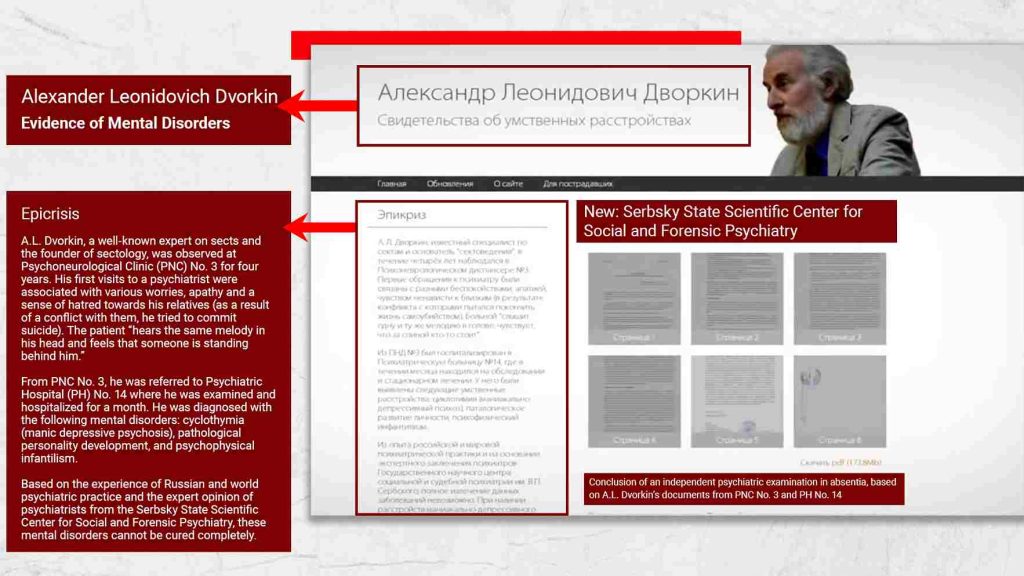
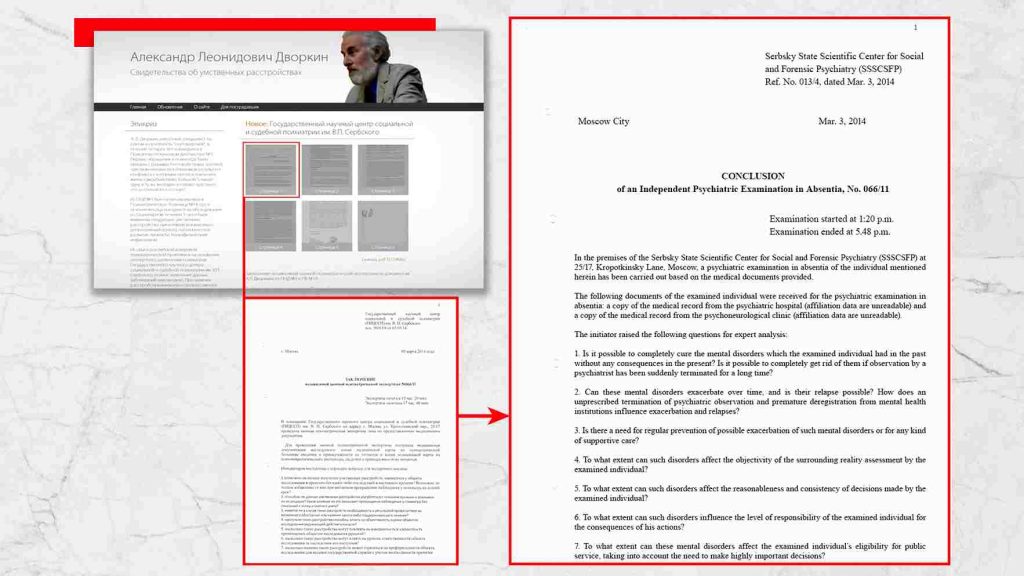

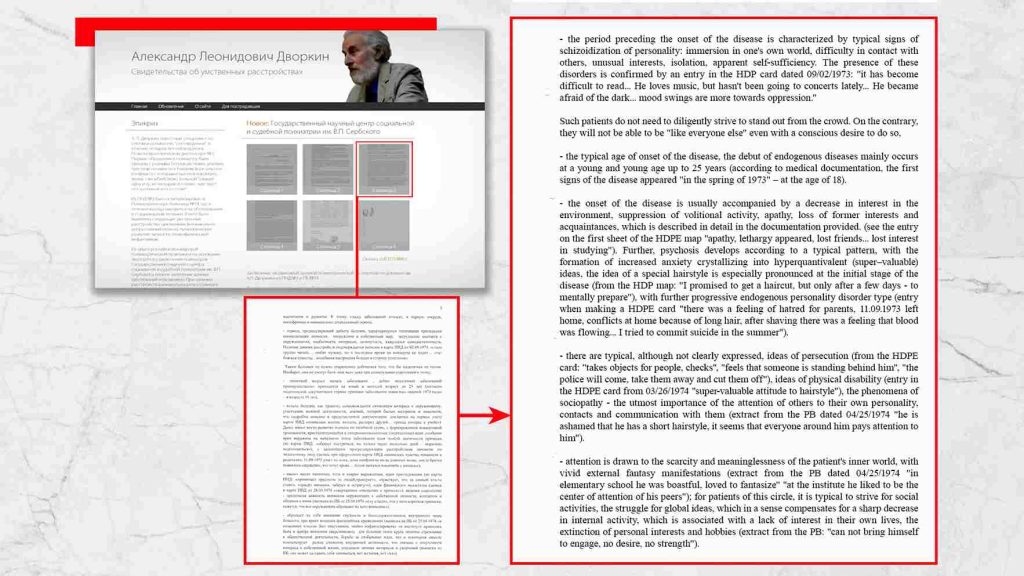
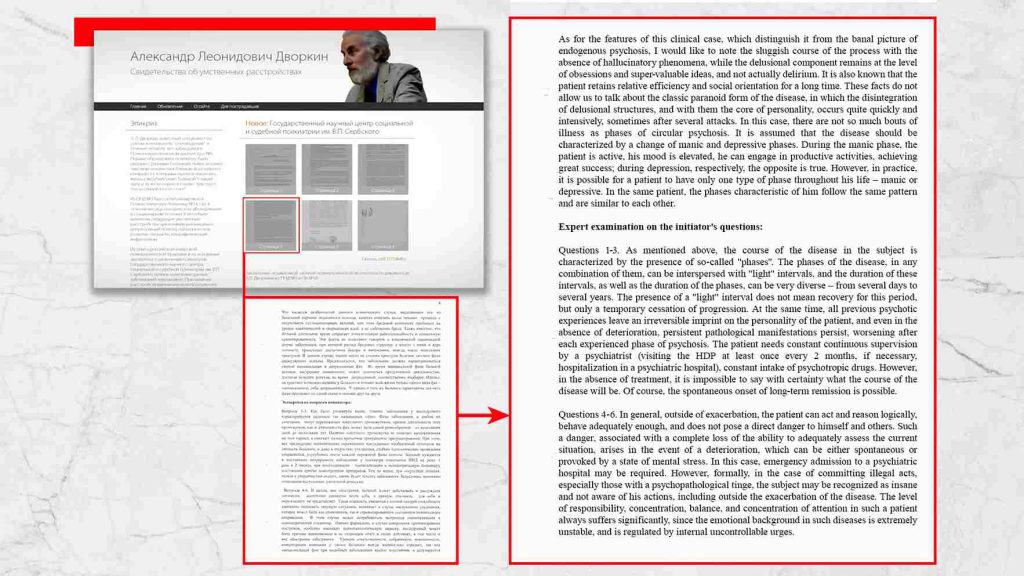
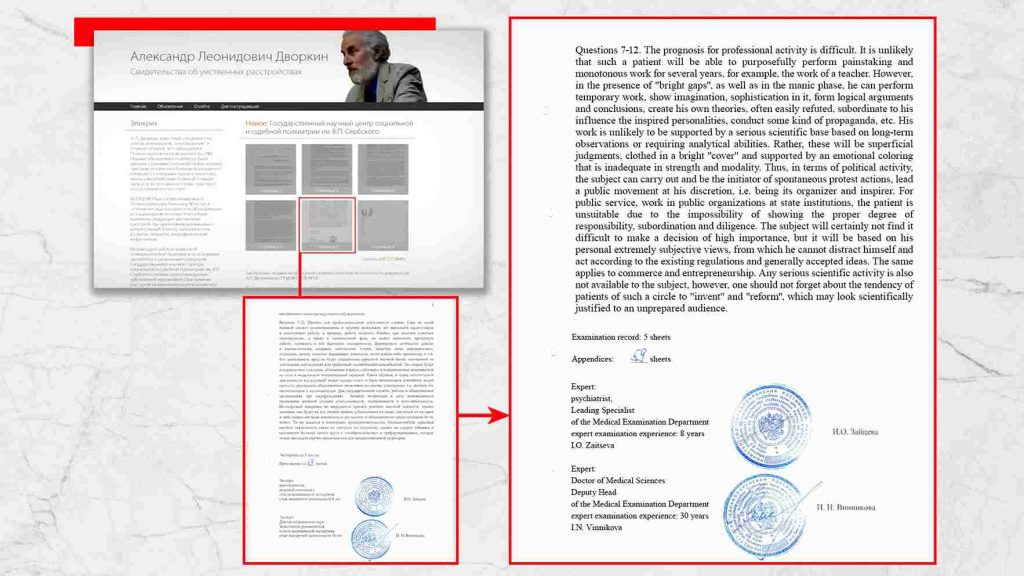
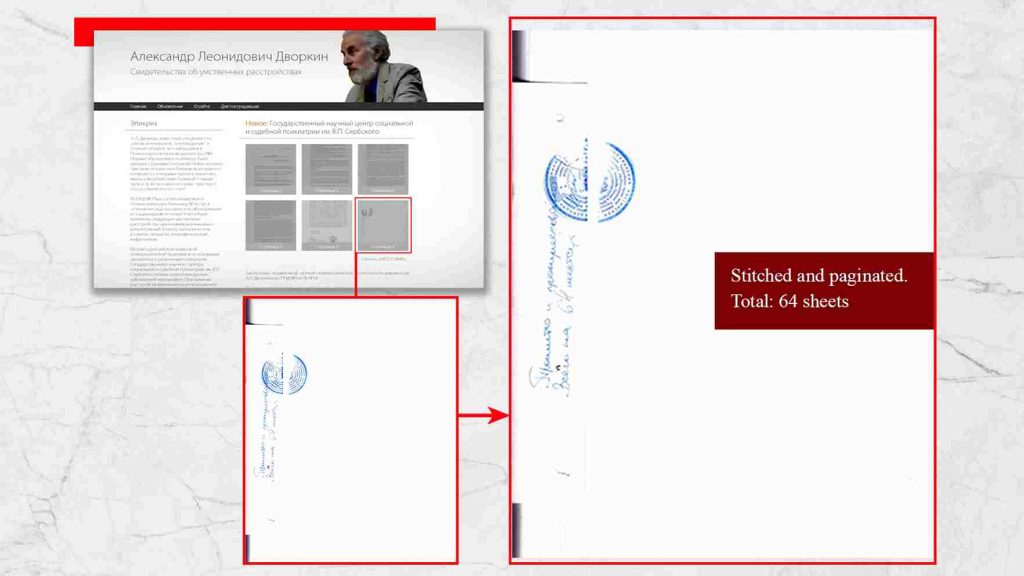
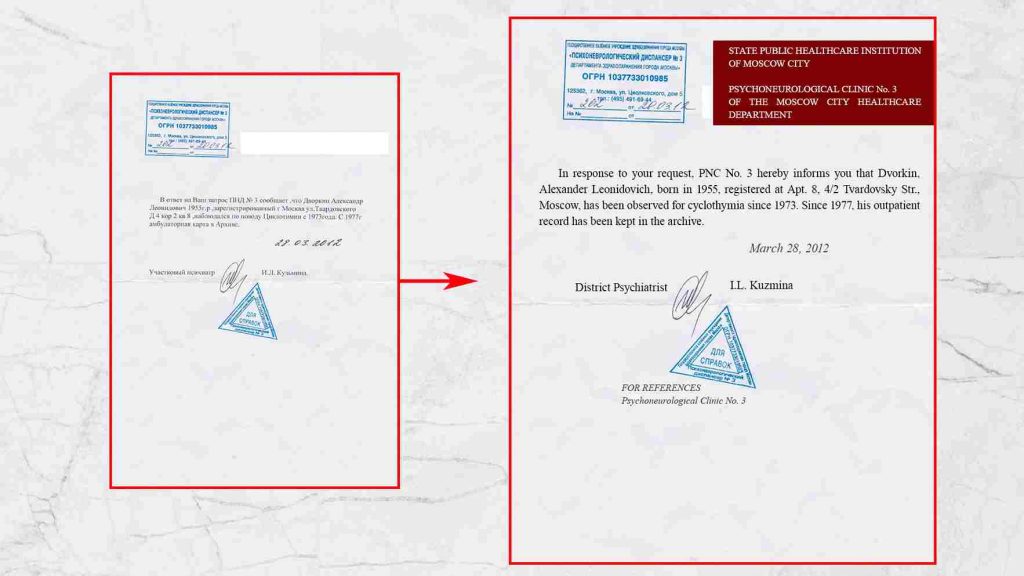
The expert examination also reports that “the patient is ineligible for public service and work in public organizations and institutions due to his inability to show a proper degree of responsibility, subordination and diligence.”

Yet, despite the expert conclusion by psychiatrists and numerous complaints from individuals and organizations about the wrongful actions of this man, he holds the position of Head of the Sect Studies Department at the Missionary Faculty of Saint Tikhon’s Orthodox University (PSTGU). He is the president of anti-cult organizations: Russian Association of Centers for the Study of Religions and Sects (RACIRS) and Center for Religious Studies in the name of Hieromartyr Irenaeus of Lyon (CRS). He also serves as Vice President of the European Federation of Centres of Research and Information on Cults and Sects (FECRIS). Moreover, since April 2009, he has been the chairman of the Expert Council for State Religious Studies Expertise at the Russian Ministry of Justice.
Unbelievably, but true: a mentally ill person determines the appropriateness and legitimacy of the actions of people who are recognized mentally healthy. A man who suffers from a severe mental disorder decides the fate of entire organizations and communities, labeling their activities as extremist. In fact, anti-cult organizations and their leader, sectologist A. Dvorkin, do not limit their activities to religious groups alone. Below is the typology of entities “having signs of destructive cults” based on their field of activity, as used by modern anti-cult organizations:
- religious groups;
- commercial groups;
- political groups;
- pseudoscientific groups;
- psychotherapeutic groups;
- healing groups;
- educational (pedagogical) groups;
- occult and esoteric groups.
A.Dvorkin’s titles and degrees sound impressive if you don’t know what is behind them. Organizations headed by Dvorkin represent the ideological center of anti-cultism, and in fact, the ideological center of Nazism of a new format. Their activities lead to undermining of democracy in many countries, incite racial, religious hatred and violence against people, and cause suffering, humiliation and deaths of millions of people around the world.
“RACIRS has decided to launch a new project — publication of a list of organizations that we know as cooperating with totalitarian sects. Such cooperation can be in a form of “business” partnership, and it can be even more integrated, up to the point that a company is a structural unit of a sect.
This list is far from being complete, for the project has just started. If you are aware of such cases of cooperation between totalitarian sects and commercial (as well as non-profit) organizations and you can prove this with good reason, please contact one of the centers being part of RACIRS.” 9
Doesn’t this remind you of anything? There were calls to report “enemies of the people” during Stalin’s repressions and to provide information about neighbors, friends and acquaintances of Jewish nationality during the times of Nazi Germany.
RACIRS (the Russian Association of Centers for the Study of Religions and Sects) is an organization that includes regional centers dealing with the issue of totalitarian sects. Its president is A.L. Dvorkin. RACIRS’ core is the Irenaeus of Lyon Center created by Dvorkin in 1993 with the support of the Russian Orthodox Church, which completely copies the activities of the Apologetic Center (Apologetische Centrale) established in 1921 by the Protestant Church in Nazi Germany. Dvorkin has accurately adopted the Nazi methods and the model of work of such centers on combating all dissenting groups of people.
At that time, hit lists for combating free thinking were handed over to the Gestapo. Whom does RACIRS give its hit lists nowadays?
Now, given there is no legal term like “sect” or “cult”, it is possible to groundlessly and with impunity accuse a person or an organization of what they actually do not commit, thus creating a precedent in public opinion. Dvorkin himself opposes introduction of a legal concept of a “sect” or “cult” because, if it were introduced, one would have to present facts and prove that a specific organization is a sect or a cult and that charges against it are really grounded. As the anti-cult movement leader himself stated, “we would lose those trials.”
“Any person can call an organization ‘sect’ with no fear of punishment if he considers it to be a sect.” A. Dvorkin
For a mentally ill person, such “logic” is acceptable. But why is it accepted by those who consider themselves mentally healthy? After all, such arbitrariness is a direct violation of all laws and constitutional rights of citizens in a democratic society, in particular: freedom of conscience, freedom of religion, and the presumption of innocence.
Here we are faced with the impact that negative images have on human consciousness and those manipulative techniques of creating such images that have been used for manipulating society over centuries. Stigmatization, or labeling, is one of those techniques. By creating negative images of specific individuals, communities of people or even entire nations, animosity and division among people on various grounds are continuously instigated, with the most intense and large-scale hostility occurring on the ground of religious beliefs. Defense of the “purity of faith” is sort of a cornerstone which everything begins from.
What do we see as a result? In its fight for the “purity of faith”, the church established the Inquisition with its tools of torture. The spiritual and ideological leaders of Nazism emerged from the church bosom. At all times, the church has been blessing fratricidal wars. With its rigid hierarchy and power structure, the church destroys anyone who doesn’t want to obey it.
How is this possible? Who instills such ideas into the minds of representatives of religious organizations? Who manipulates their consciousness? Answers to these questions are voiced in “The IMPACT” documentary where, based on numerous facts, the true goals of anti-cult organizations and those behind them have been exposed.
Nowadays, RACIRS is indeed the ideological center of the modern anti-cult movement and a global trendsetter of its propaganda methods — those methods which led to the rise of Nazism in its time. Representatives of the anti-cult movement are members of major religious organizations or closely cooperate with them. They promote the image of “cults” and “sects” as dangerous communities. Their hit lists currently include millions of people worldwide. They have already caused millions of human deaths through tortures and murders, and have affected even more human lives through information impact via mass media. Hundreds of thousands of people are currently imprisoned or kept in concentration camps. We will tell their stories in more detail in subsequent articles.
“Cult members and sectarians are insane, brainwashed, programmed, and dangerous; they are non-humans subject to isolation and destruction; they are inferior members of society.” Such an image is now being actively disseminated by representatives of anti-cult organizations, and this label is pinned on an increasing number of people across the world every day.
The method of labeling is a dangerous and harsh way to exclude any “ideological enemy” from society, whether it’s an individual, a group of people or even a whole nation. In fact, the label “cultist” or “sectarian” denotes a target that can and should be destroyed. Today, the “cult” and “sect” labels pinned on people and organizations by anti-cultists with impunity are similar to the yellow star badges that the Nazis forced Jews to wear. Ultimately, this stigmatization resulted in one of the most tragic pages in human history — the Holocaust.
However, it seems like history shows that it teaches us nothing. Pages of our history keep being filled with new tragedies caused by the activities of anti-cult organizations. An example of the consequences of this kind of stigmatization is the torture and execution undergone by the followers of Falun Gong, or Falun Dafa (a new religious movement based on traditional Chinese qigong gymnastics combined with elements of Buddhism, Taoism, Confucianism, and Chinese folk beliefs).




Why are these people being tortured? For choosing a certain way of life that doesn’t harm or threaten anyone and for remaining faithful to it? This is happening nowadays, in the 21st century! In the 21st century, people undergo tortures that were used by the medieval Inquisition, the fascist Gestapo and the NKVD in their dungeons. Brutal methods of violence against people haven’t changed over centuries. These methods compel one to submit to a single force that establishes its right to control human lives, dealing with people like a maniac.
Meanwhile, what values are professed by executioners representing that hidden force? What kind of “lifestyle” is advocated by those who are capable of such atrocities?
What has been prepared for all of us by those who brutally and cynically dealt with civilians in Waco, first labeling them as a ”destructive cult” and then staging a demonstrative massacre of those people and their children just because they interpreted the Bible in a different way? 86 people, 25 among them being children including infants and kids under 3 years old, were first poisoned with paralyzing gas (the chemical warfare agent CS), and thereafter their house was set on fire, where they burned to death.
Even in much lower doses than those used in Waco, CS kills children, while large amounts of this gas have a strong spasmodic effect when muscles cramp so much that bones break.
- “FBI Representative: We put massive gas in there. Their gas masks by that time had to be failing.
- Mr. Zimmermann: I believe that using CS gas against infants, against old people with respiratory problems (there were 60-70-year-old men in there, and there were young children), that’s torture. And I can just see those kids barfing, vomiting, screaming, because you can’t possibly have a gas mask to fit a little kid.
- Dr. Erik Larsen: They would be coughing, choking. They would probably be unconscious. Uh, some of them would probably be dead. Some would be, basically, inert. They may still be alive, they may still be breathing, but they’re not going to be doing anything.”
The falling walls, destroyed by armored vehicles, effectively killed some of the Davidians, as evidenced by forensic reports. The tank repeatedly drove over their bodies, tearing them apart.

As the anti-cultists declared, these people were participants in a dangerous destructive cult and posed a serious threat to the country. Therefore, they were first publicly stigmatized as cult members and then destroyed.

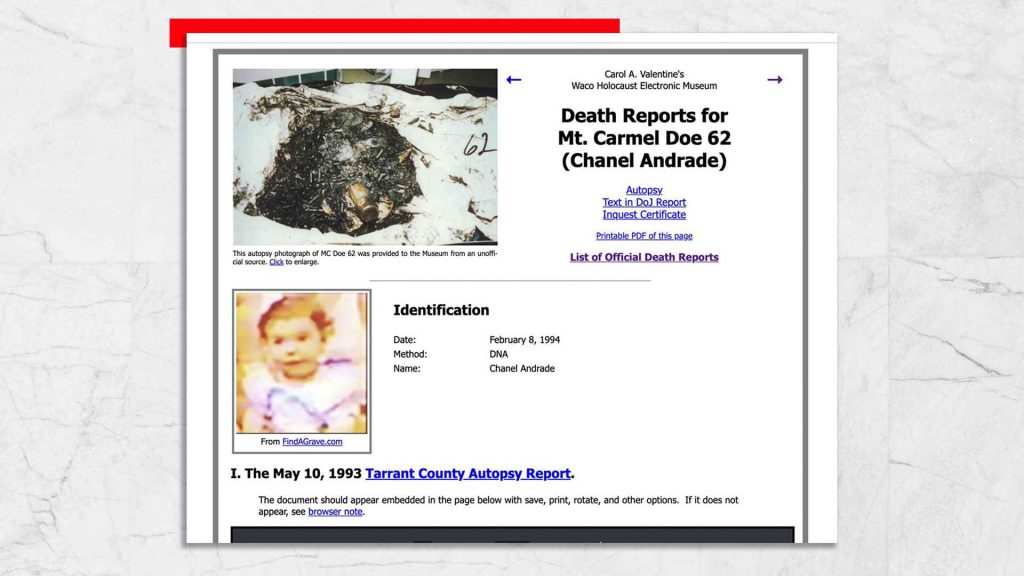
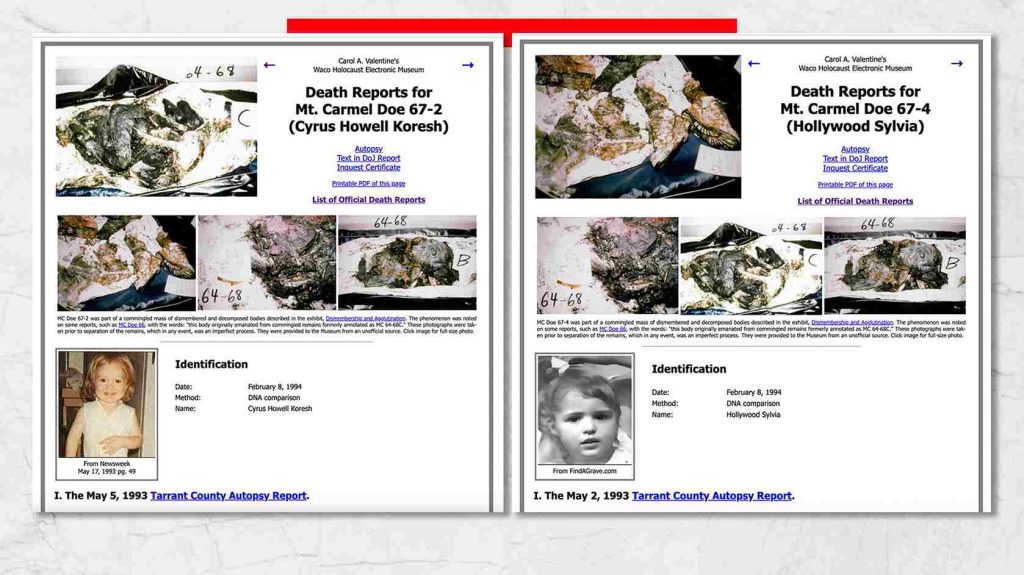

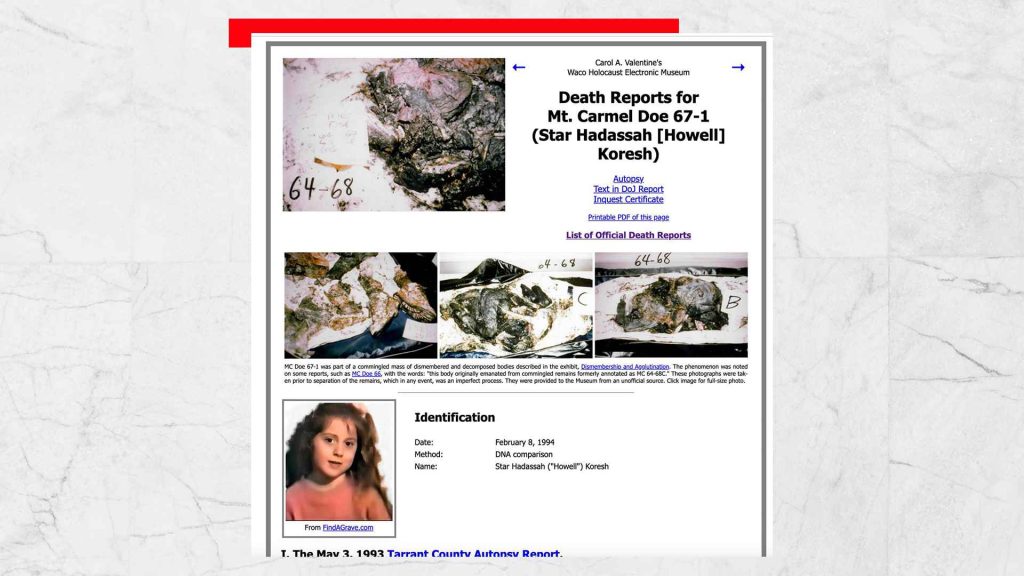

The press wrote that “85 cultists died”, not even calling them people, which implies that no pity or regret should be felt towards them.
That’s how in present-day society those stigmatized as “cultists” or “sectarians” are dealt with. For many centuries, anti-cultists have been pinning such labels on those whom they wanted to destroy.
The Waco tragedy with the terrible deaths of innocent people and their children is essentially an act of genocide carried out by anti-cultists at the hands of public authorities and law enforcement. Those who committed this crime were no different from the Nazis during World War II.
In our times, anti-cultists force us to use Nazi methods to destroy each other, pinning the labels “totalitarian sect” and “destructive cult” on an increasing number of organizations and individuals day by day.
This is clear evidence that Nazism has never disappeared and still actively persists. Labeling various groups of people as “cults” and “sects”, anti-cultists thereby alienate them from society, depriving them of the status of humans. These labels take away their democratic rights and freedoms, communicating to society that these people are not like everyone else, that they may be deprived of their rights and treated without respect and even with violence. The method of labeling practically implies an official permission of violence against people who are “non-humans”, in the opinion of anti-cultists. While in reality, anti-cultists themselves are adherents of the cult of intolerance, inhumanity and obsession with the idea of their own superiority and chosenness. They claim to be the arbiters of human destinies while being from time immemorial the sowers of enmity, hatred, fear, and death.
Today, the anti–cult movement is a well-coordinated transnational terrorist network aimed at inciting hatred both within countries and in the global community by labeling certain groups of people as “cults” or “sects” through mass media and the information space. These labels are nothing but weapons of mass destruction — the weapons by means of which we as society are being led to complete destruction of democracy and human liberties and to the establishment of a single totalitarian regime all over the globe.
Who are we?
Are we a society of branded slaves or a society of free people? Everyone has to answer this question, and everyone has to make their choice. What will rule in this world? Love and mercy, or tyranny and Nazism? This is what all of us need to decide together. By publicizing truthful information about the activities of anti-cult organizations, we will be able to rid the world of the most horrible kind of terror.
Sources:
1. www.gnosis.study/library/%D0%9A%D1%80%D0%B8%D1%82%D0%B8%D0%BA%D0%B0/RUS/%D0%98%D1%80%D0%B8%D0%BD%D0%B5%D0%B9%20%D0%9B%D0%B8%D0%BE%D0%BD%D1%81%D0%BA%D0%B8%D0%B9%20-%20%D0%9F%D1%80%D0%BE%D1%82%D0%B8%D0%B2%20%D0%B5%D1%80%D0%B5%D1%81%D0%B5%D0%B9.pdf
2. www.de.m.wikipedia.org/wiki/J%C3%B6rg_Lanz_von_Liebenfels
3. www.biblegateway.com/passage/?search=Matthew+23%3A8-10&version=NKJV
4. www.booklooker.de/B%C3%BCcher/Bertil-Persson+The-Fight-against-Sects/id/A02F8J1701ZZf
5. www.en.wikipedia.org/wiki/Inquisition
6. www.biblegateway.com/passage/?search=John+13%3A34-35&version=NKJV
7. www.biblegateway.com/passage/?search=Luke+6%3A36-38&version=NKJV
8. www.biblegateway.com/passage/?search=1+John+3%3A10&version=NIV
9. www.andronnik26.livejournal.com/17334.html
10. www.whem.org/death/map/d_list08.html


